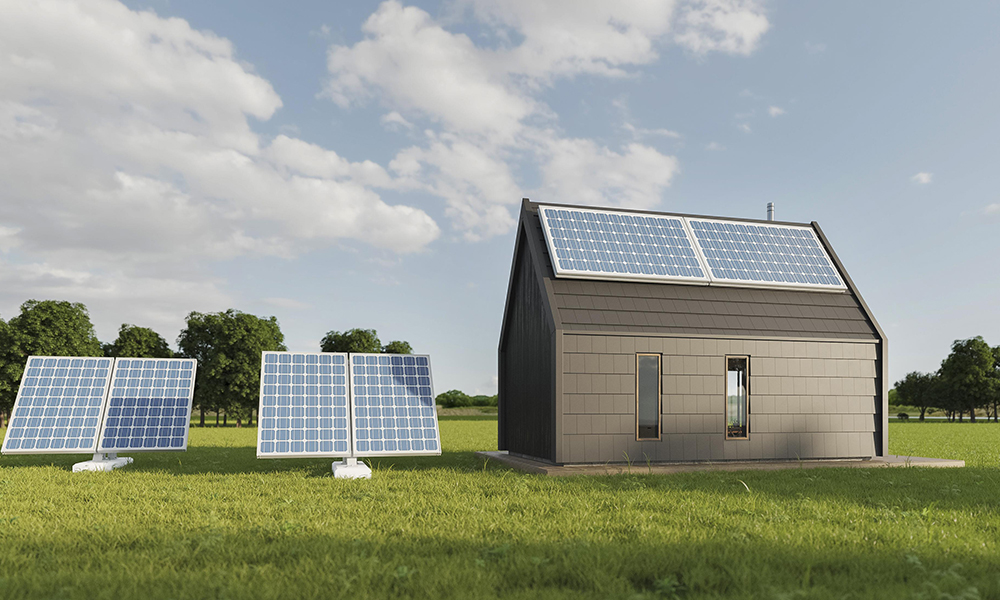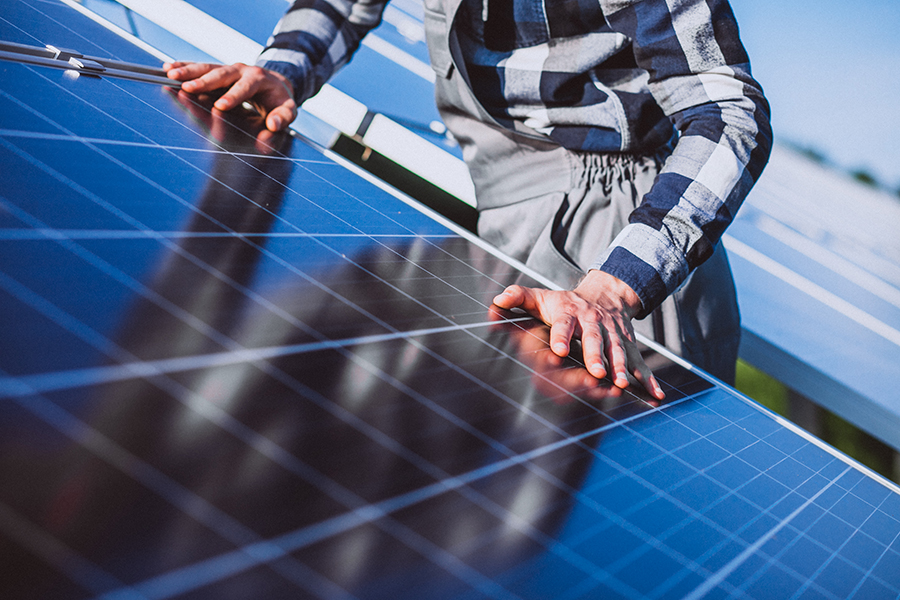As the U.S. government pledges $1 billion to develop solar power, local leaders push back on utility-scale arrays and point to a community microgrid as an example of the future they want to see.
The U.S. Department of Energy has committed $1 billion to develop solar energy in Puerto Rico, to help the island meet its goal of 100% renewables and to add resilience to a system plagued by hurricane damage, poor maintenance and debilitating blackouts. Energy Secretary Jennifer Granholm has visited the island multiple times, and the department has promised additional funding for renewables once an in-depth study is completed.
Community leaders who have long pushed for solar are hopeful. But they are adamant that the funding must prioritize community-driven, decentralized rooftop solar. They don’t want to see more solar farms, which they say can damage land and continue reliance on shipping power across the island; and they are skeptical of the role of LUMA, the company that runs Puerto Rico’s grid since it was privatized in June 2021.
On March 18, Casa Pueblo, a prominent community organization in the mountain town of Adjuntas, will inaugurate “Adjuntas Pueblo Solar,” an independent solar project that will supply 20 businesses with solar energy. The inauguration will coincide with Casa Pueblo’s “Marcha del Sol: Puerto Rico Triunfa,” where residents and national and international groups will gather for cultural activities and typical Puerto Rican food.
Clean energy advocates see Casa Pueblo’s work including Adjuntas Pueblo Solar as an island-wide model, allowing communities energy independence and the ability to decide what solar projects work best in their own areas, including with the new funding.
On Feb. 21, the Department of Energy released a formal request for information regarding the Puerto Rico Energy Resilience Fund, through which the department will manage the $1 billion.
The request came days after contentious hearings in the capital, San Juan, regarding LUMA Energy’s performance in managing the grid, and new metrics the company must meet, including on the interconnection of solar. The hearings revealed shortcomings in LUMA’s ability to administer and maintain the grid.
In the request for comments, open through April 21, the Department of Energy says it wants to hear from “industry, community-based organizations, federal and state government agencies, state and local coalitions, research institutions, and other stakeholders.”
The department has said funding for solar will roll out as soon as this summer, prioritizing “vulnerable households and households that include individuals with disabilities.”
The funding will be administered through the newly formed Energy Resilience Fund, which is managed by the department’s Grid Deployment Office in consultation with the Federal Energy Management Agency and the Department of Housing and Urban Development. A second round of funding will focus on energy resilience solutions like microgrids and community solar, similar to what Casa Pueblo did at Adjuntas Pueblo Solar.
“There are many eyes on this project,” said Alexis Massol González, founder of Casa Pueblo. “This is a top-notch model. … We Puerto Ricans are proud of having a project like this. May the Department of Energy come and study it.”
A larger plan for energy resilience
The Department of Energy will start allocating the energy resilience funding while also continuing an ongoing study, known as the Puerto Rico Grid Resilience and Transitions to 100% Renewable Energy Study, or PR100. That study is scheduled for release in December 2023, and the department has promised that based on the results additional funding will be allocated.
A PR100 progress report released after its first year calls for widespread installation of rooftop solar panels in Puerto Rico, to provide decentralized energy and make people less reliant on the troubled grid, including high-voltage transmission wires that send energy from power plants on the south coast to population centers in the north.
Disseminating information about this study was one of the goals of Granholm’s visit in early February. She met with residents and local leaders in Salinas, Vieques, Culebra, and Loíza — communities hit hard by hurricanes, disinvestment, and pollution from fossil fuel power plants and waste.
“I noticed that she was very considerate and listened to all the stakeholders,” said Alberto Colón, from Comunidad Guayamesa, an organization that installs and maintains solar panels for elderly residents in Guayama, a town on the south coast near AES’s massive coal plant. “I understand that it is not the same that you sit at a table and someone tells you something, compared to you actually going there and seeing it for yourself.”
During Hurricane María in 2017, Guayama and surrounding communities suffered landslides and flooding that spread toxic coal ash. Many families were without power for months.
To promote energy resilience, Colón and other community members installed solar panels on 25 homes and plan to add five more. But the funding they received was used only for installation. When the projects need repairs, “we sacrifice our own pockets,” he said. “It’s not a matter of installing the equipment and leaving it in God’s hands. We make sure to give it the necessary maintenance.”
There are several large solar farms near Guayama, but residents feel these installations have exacerbated flooding and taken land that should be used for crops. They are adamant that new solar should come in smaller rooftop arrays, not as utility-scale solar.
“If we have enough rooftops to do the work, it is unnecessary to sacrifice the land to generate what we need,” Colón said. “We have enough rooftops to generate three, four times what we need.” Indeed the PR100 one-year progress report, whose scenarios “rely on a significant increase in rooftop solar,” found that “renewable energy potential in Puerto Rico significantly exceeds total energy demand now and through 2050.”
Colón hopes Granholm will recommend to the governor of Puerto Rico that the island’s administration “decides once and for all to install rooftop solar panels.” “We are crossing our fingers that it happens this way,” Colón said.
In Salinas, a municipality near Guayama, a community center called Centro Comunal El Coquí also provides families with rooftop solar panels, having installed the equipment in four households. Like Colón, leaders in Salinas want solar energy to be deployed through rooftops instead of solar farms. They’ve intervened in legal proceedings to try to block utility-scale solar farms in the region, without success.
“Community groups and environmental groups generally throughout Puerto Rico favor distributed renewable energy, not utility-scale, for a lot of reasons,” said Ruth Santiago, an environmental lawyer who lives in Salinas and has represented nonprofit organizations and community groups for over 30 years. “We have sprawling construction in Puerto Rico — because of the limited geographic space — and we are already below the agricultural land preservation target.”
The sense of urgency in communities like Guayama and Salinas has its roots in years of struggle with the grid including after hurricanes Irma, María and Fiona.
“We are tired,” said Rómulo Ortiz, from Centro Comunal El Coquí. “We are tired, and we want action.”
Residents’ frustration and anger are aggravated by the lack of data on the grid situation.
This failing was discussed during evidentiary hearings between Feb. 7 and Feb. 10 at the Energy Bureau, the independent agency that regulates energy on the island. The hearings aimed to set targets and ways to measure LUMA’s performance in operating and maintaining the grid.
During the meetings, LUMA employees said it is difficult to measure the total amount of energy that enters the transmission system, and they have struggled to locate customers with complaints about outages or diagnose problems with the system.
On the second day of the hearings, LUMA officials were unable to provide an estimate of how much of the grid it had assessed. Energy Bureau President Edison Avilés-Deliz said it is part of LUMA’s duties to conduct these general assessments and that the company had had enough time to do it. “I cannot believe it, honestly,” he said.
The vice president for utility transformation at LUMA, Don Cortez, said four more years of inventory work would be necessary to establish the actual condition of the system “pole by pole.”
Critics say the island doesn’t have that much time, another reason why new decentralized solar installations are necessary.
During the hearings, economist and professor José Alameda-Lozada described access to energy as a human right. He suggested a new system of penalties and compensation for LUMA that would try to ensure LUMA provides better service. In other testimony, University of Puerto Rico electrical engineering professor Agustín Rivera said that the Energy Bureau should create a metric to measure the modernity of Puerto Rico’s electric system.
“We are in the process of leaving behind centralized generation,” said Avilés-Deliz in response to these suggestions. “There are a lot of changes. We need to go step by step.”
New interconnection goals
After the evidentiary hearings at Puerto Rico’s Energy Bureau, LUMA will need, for the first time, to comply with specific metrics on interconnecting solar, including presumably new solar funded with the $1 billion. According to Puerto Rico’s interconnection law, LUMA is required to complete interconnection projects within 30 days, but that deadline is often not met. According to testimony reviewed during the hearings, LUMA’s average duration for activation was approximately 33 days in the first quarter of fiscal year 2023, and reached 36 days in the second quarter of the same fiscal year. But LUMA has previously not needed to report metrics to show its performance on interconnection.
“LUMA didn’t have an interconnection metric,” said Santiago, who also wants LUMA to present residents with formal interconnection and net metering agreements. “They didn’t want it; they opposed it.”
During the hearings, Commissioner Lilian Mateo said metrics need to be designed to achieve and go beyond the mandates of the interconnection law, even as LUMA will likely see a significant increase in demands for interconnection.
LUMA did not respond to emailed questions about interconnection or requests for an interview.
A potential model
Casa Pueblo has long been a model for solar energy and community resilience.
Before launching Adjuntas Pueblo Solar, Casa Pueblo had already provided solar panels to more than 350 homes and businesses in the small mountainside town throughout the years, and residents came from other hurricane-damaged areas in the aftermath of 2017’s hurricanes Irma and María.
After Hurricane María, “Casa Pueblo became an energy oasis,” Massol González said, where people would go to make phone calls made possible by energy from the solar panels. Solar fueled a radio station that broadcast throughout the crisis, providing crucial information and helping family members find each other.
The work to create Adjuntas Pueblo Solar started in April 2019, with the aim of reducing commercial buildings’ energy costs and “creat[ing] a commitment with the planet,” Massol González said.
A bakery, pizza place and ice cream shop are among the businesses newly acquiring solar on their roofs. With the help of two microgrids, they will share excess energy with other businesses in a cooperative way.
Massol González and his allies don’t want to ditch the island’s larger grid altogether. Rather, they want to install solar connected to the grid, helping to make the whole system less reliant on fossil fuels and more resilient.
“We are not destroying the country’s model,” Massol González said. “It is a way of fortifying the country’s model.”
Carolina Baldin is a lawyer from Brazil with experience in public policy. This story originally appeared in EnergyNews.us and is republished here as part of Covering Climate Now, a global journalism collaboration strengthening coverage of the climate story.






